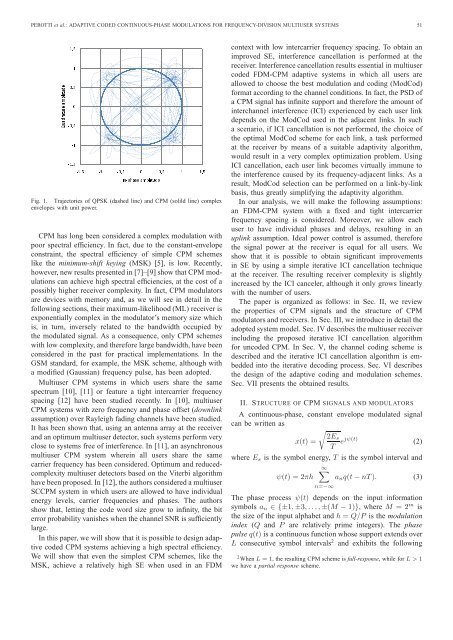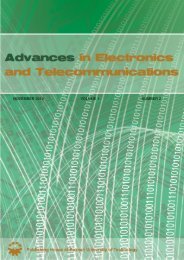channel - Advances in Electronics and Telecommunications
channel - Advances in Electronics and Telecommunications
channel - Advances in Electronics and Telecommunications
Create successful ePaper yourself
Turn your PDF publications into a flip-book with our unique Google optimized e-Paper software.
PEROTTI et al.: ADAPTIVE CODED CONTINUOUS-PHASE MODULATIONS FOR FREQUENCY-DIVISION MULTIUSER SYSTEMS 51<br />
Fig. 1. Trajectories of QPSK (dashed l<strong>in</strong>e) <strong>and</strong> CPM (solild l<strong>in</strong>e) complex<br />
envelopes with unit power.<br />
CPM has long been considered a complex modulation with<br />
poor spectral efficiency. In fact, due to the constant-envelope<br />
constra<strong>in</strong>t, the spectral efficiency of simple CPM schemes<br />
like the m<strong>in</strong>imum-shift key<strong>in</strong>g (MSK) [5], is low. Recently,<br />
however, new results presented <strong>in</strong> [7]–[9] show that CPM modulations<br />
can achieve high spectral efficiencies, at the cost of a<br />
possibly higher receiver complexity. In fact, CPM modulators<br />
are devices with memory <strong>and</strong>, as we will see <strong>in</strong> detail <strong>in</strong> the<br />
follow<strong>in</strong>g sections, their maximum-likelihood (ML) receiver is<br />
exponentially complex <strong>in</strong> the modulator’s memory size which<br />
is, <strong>in</strong> turn, <strong>in</strong>versely related to the b<strong>and</strong>width occupied by<br />
the modulated signal. As a consequence, only CPM schemes<br />
with low complexity, <strong>and</strong> therefore large b<strong>and</strong>width, have been<br />
considered <strong>in</strong> the past for practical implementations. In the<br />
GSM st<strong>and</strong>ard, for example, the MSK scheme, although with<br />
a modified (Gaussian) frequency pulse, has been adopted.<br />
Multiuser CPM systems <strong>in</strong> which users share the same<br />
spectrum [10], [11] or feature a tight <strong>in</strong>tercarrier frequency<br />
spac<strong>in</strong>g [12] have been studied recently. In [10], multiuser<br />
CPM systems with zero frequency <strong>and</strong> phase offset (downl<strong>in</strong>k<br />
assumption) over Rayleigh fad<strong>in</strong>g <strong>channel</strong>s have been studied.<br />
It has been shown that, us<strong>in</strong>g an antenna array at the receiver<br />
<strong>and</strong> an optimum multiuser detector, such systems perform very<br />
close to systems free of <strong>in</strong>terference. In [11], an asynchronous<br />
multiuser CPM system where<strong>in</strong> all users share the same<br />
carrier frequency has been considered. Optimum <strong>and</strong> reducedcomplexity<br />
multiuser detectors based on the Viterbi algorithm<br />
have been proposed. In [12], the authors considered a multiuser<br />
SCCPM system <strong>in</strong> which users are allowed to have <strong>in</strong>dividual<br />
energy levels, carrier frequencies <strong>and</strong> phases. The authors<br />
show that, lett<strong>in</strong>g the code word size grow to <strong>in</strong>f<strong>in</strong>ity, the bit<br />
error probability vanishes when the <strong>channel</strong> SNR is sufficiently<br />
large.<br />
In this paper, we will show that it is possible to design adaptive<br />
coded CPM systems achiev<strong>in</strong>g a high spectral efficiency.<br />
We will show that even the simplest CPM schemes, like the<br />
MSK, achieve a relatively high SE when used <strong>in</strong> an FDM<br />
context with low <strong>in</strong>tercarrier frequency spac<strong>in</strong>g. To obta<strong>in</strong> an<br />
improved SE, <strong>in</strong>terference cancellation is performed at the<br />
receiver. Interference cancellation results essential <strong>in</strong> multiuser<br />
coded FDM-CPM adaptive systems <strong>in</strong> which all users are<br />
allowed to choose the best modulation <strong>and</strong> cod<strong>in</strong>g (ModCod)<br />
format accord<strong>in</strong>g to the <strong>channel</strong> conditions. In fact, the PSD of<br />
a CPM signal has <strong>in</strong>f<strong>in</strong>ite support <strong>and</strong> therefore the amount of<br />
<strong>in</strong>ter<strong>channel</strong> <strong>in</strong>terference (ICI) experienced by each user l<strong>in</strong>k<br />
depends on the ModCod used <strong>in</strong> the adjacent l<strong>in</strong>ks. In such<br />
a scenario, if ICI cancellation is not performed, the choice of<br />
the optimal ModCod scheme for each l<strong>in</strong>k, a task performed<br />
at the receiver by means of a suitable adaptivity algorithm,<br />
would result <strong>in</strong> a very complex optimization problem. Us<strong>in</strong>g<br />
ICI cancellation, each user l<strong>in</strong>k becomes virtually immune to<br />
the <strong>in</strong>terference caused by its frequency-adjacent l<strong>in</strong>ks. As a<br />
result, ModCod selection can be performed on a l<strong>in</strong>k-by-l<strong>in</strong>k<br />
basis, thus greatly simplify<strong>in</strong>g the adaptivity algorithm.<br />
In our analysis, we will make the follow<strong>in</strong>g assumptions:<br />
an FDM-CPM system with a fixed <strong>and</strong> tight <strong>in</strong>tercarrier<br />
frequency spac<strong>in</strong>g is considered. Moreover, we allow each<br />
user to have <strong>in</strong>dividual phases <strong>and</strong> delays, result<strong>in</strong>g <strong>in</strong> an<br />
upl<strong>in</strong>k assumption. Ideal power control is assumed, therefore<br />
the signal power at the receiver is equal for all users. We<br />
show that it is possible to obta<strong>in</strong> significant improvements<br />
<strong>in</strong> SE by us<strong>in</strong>g a simple iterative ICI cancellation technique<br />
at the receiver. The result<strong>in</strong>g receiver complexity is slightly<br />
<strong>in</strong>creased by the ICI canceler, although it only grows l<strong>in</strong>early<br />
with the number of users.<br />
The paper is organized as follows: <strong>in</strong> Sec. II, we review<br />
the properties of CPM signals <strong>and</strong> the structure of CPM<br />
modulators <strong>and</strong> receivers. In Sec. III, we <strong>in</strong>troduce <strong>in</strong> detail the<br />
adopted system model. Sec. IV describes the multiuser receiver<br />
<strong>in</strong>clud<strong>in</strong>g the proposed iterative ICI cancellation algorithm<br />
for uncoded CPM. In Sec. V, the <strong>channel</strong> cod<strong>in</strong>g scheme is<br />
described <strong>and</strong> the iterative ICI cancellation algorithm is embedded<br />
<strong>in</strong>to the iterative decod<strong>in</strong>g process. Sec. VI describes<br />
the design of the adaptive cod<strong>in</strong>g <strong>and</strong> modulation schemes.<br />
Sec. VII presents the obta<strong>in</strong>ed results.<br />
II. STRUCTURE OF CPM SIGNALS AND MODULATORS<br />
A cont<strong>in</strong>uous-phase, constant envelope modulated signal<br />
can be written as<br />
�<br />
2Es<br />
x(t) =<br />
T ejψ(t)<br />
(2)<br />
where Es is the symbol energy, T is the symbol <strong>in</strong>terval <strong>and</strong><br />
∞�<br />
ψ(t) = 2πh anq(t − nT ). (3)<br />
n=−∞<br />
The phase process ψ(t) depends on the <strong>in</strong>put <strong>in</strong>formation<br />
symbols an ∈ {±1, ±3, . . . , ±(M − 1)}, where M = 2 m is<br />
the size of the <strong>in</strong>put alphabet <strong>and</strong> h = Q/P is the modulation<br />
<strong>in</strong>dex (Q <strong>and</strong> P are relatively prime <strong>in</strong>tegers). The phase<br />
pulse q(t) is a cont<strong>in</strong>uous function whose support extends over<br />
L consecutive symbol <strong>in</strong>tervals 2 <strong>and</strong> exhibits the follow<strong>in</strong>g<br />
2 When L = 1, the result<strong>in</strong>g CPM scheme is full-response, while for L > 1<br />
we have a partial response scheme.







